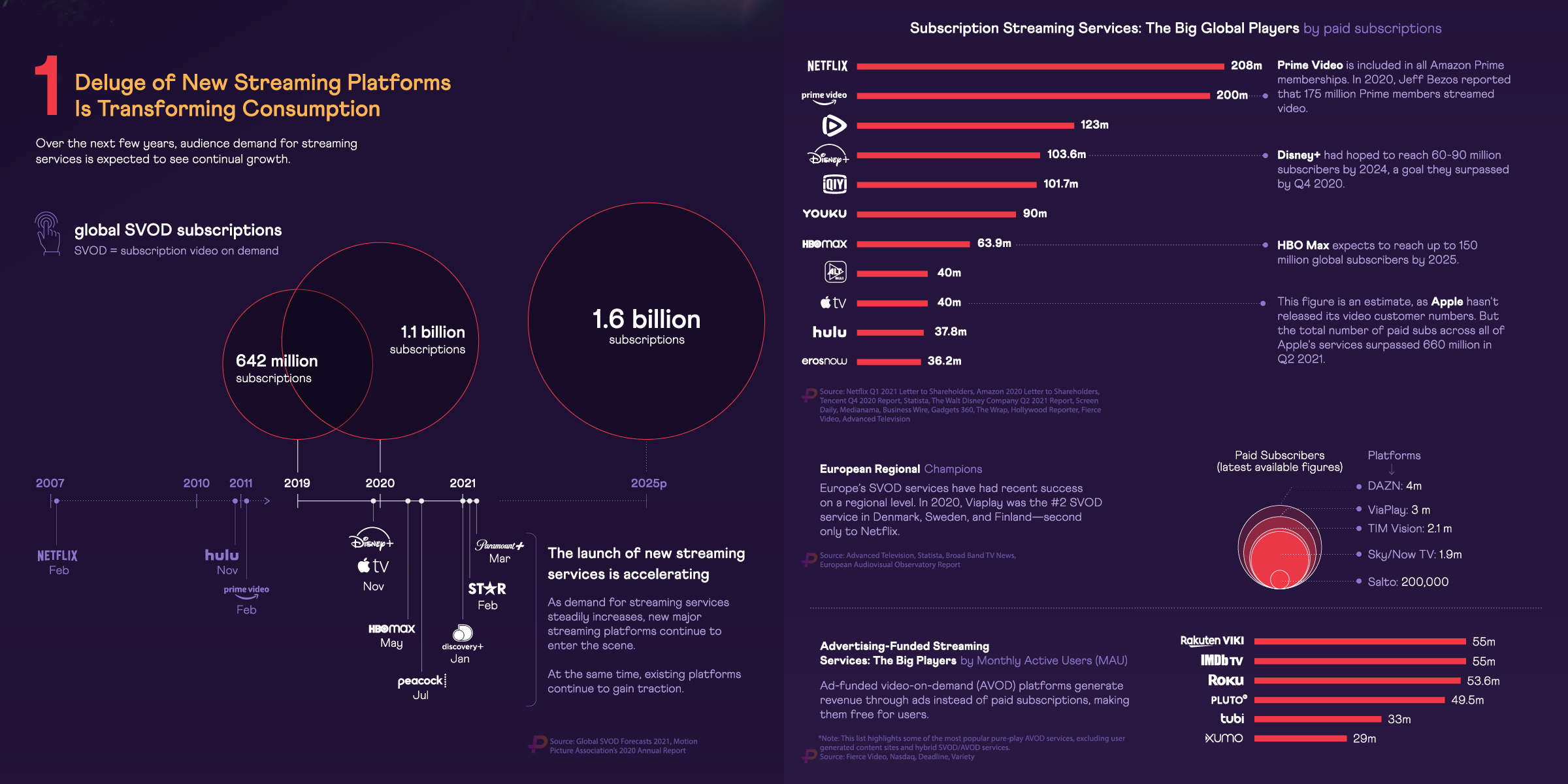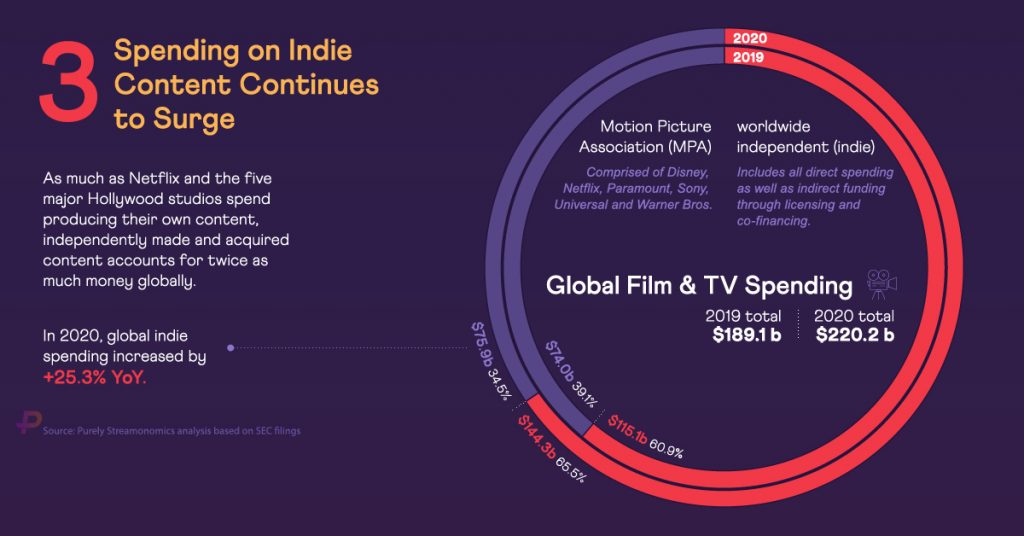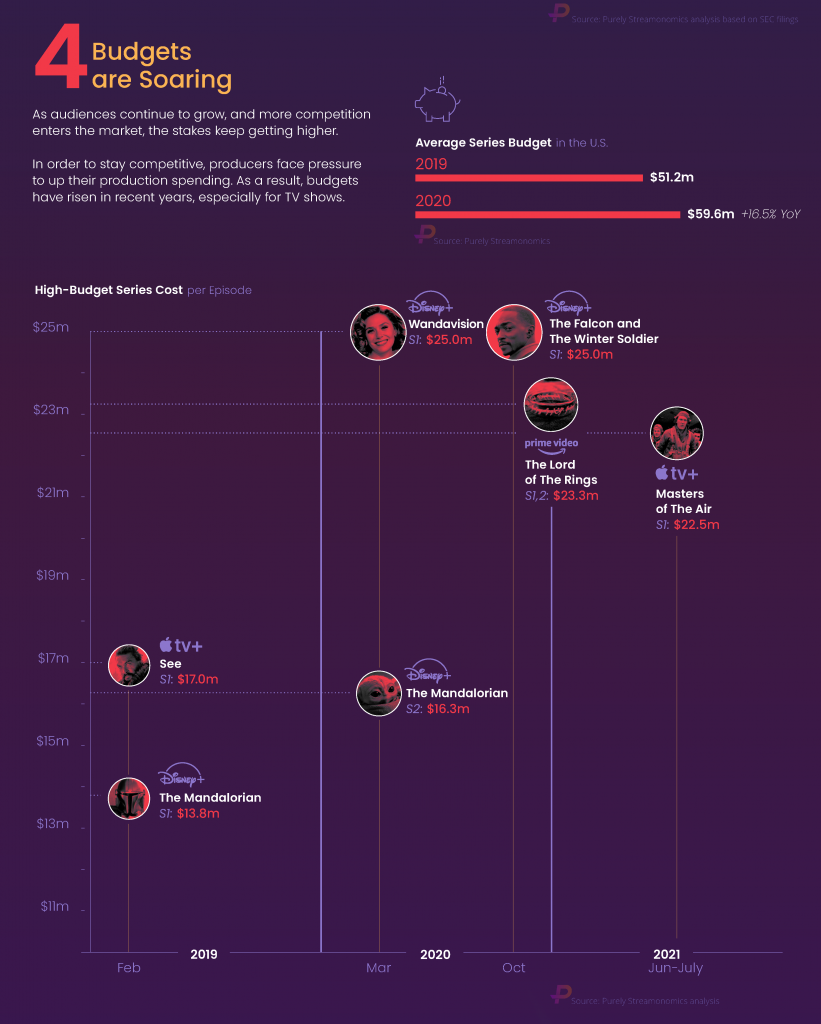
Deluge of New Streaming Platforms. Courtesy of Purely Streamonomics.
Fresh data being published by Purely Streamonomics, a new research and analytical service from Purely, shows that amidst a year of uncertainty and production hiatuses due to the global pandemic, streaming platforms have set the global film and TV industry on a trajectory of accelerated growth with no imminent ceiling in sight. The gross cash amount spent producing and licensing new entertainment content (excluding sports) soared by 16.4% in 2020 to reach $220.2 billion. This new milestone will likely be surpassed this year as well, with Purely anticipating a total spend of more than $250 billion in 2021.
Presented in the form of a specially commissioned infographic, created by Visual Capitalist, the Purely Streamonomics data presents a forensically researched picture of how audience demand, content expenditure, and TV budgets all reached all-time highs. But this is only the start of what’s to come. Even more spending growth is on the short-term horizon as a new wave of ad-supported platforms start gaining a stronger foothold around the world, alongside the subscription-funded services that have been driving the streaming marketplace until now.
Can growth in Europe keep up?
Production spend from companies based in North America is up 16.1%, in line with the overall figure, while dramatic uplifts can be seen from regional business spend in the smaller markets of Africa and the Middle East (+46.3%), Latin America (+32.9%) and Oceania (+32.5%), fuelled by rapidly growing local streamers such as Shahid VIP in the Middle East, which has recently committed to spending an additional $100m per year on original content. European company spend, which is currently less than a quarter of that in the US and Canada, failed to keep pace, rising by 11.8%. As local streamers such as Viaplay in the Nordics and Movistar+ in Spain expand their offering, this figure would be expected to rise in Europe.

Companies vs. continents
The planet’s biggest single spender on content remains The Walt Disney Company with a grossed-up total of $28.6 billion for 2020 – which is more than spend across the whole of Asia ($27.7 billion) last year. The recent announcement that Warner Media and Discovery are being combined into a unified media empire whose content spending totalled $20.8 billion means that Netflix has now been pushed into third place on the Hollywood spending charts with its $15.1 billion outlay last year. Once Amazon completes its own acquisition of MGM, that combined entity would rank as the fourth-largest North American production force with a content spend of $11.8 billion. On that basis, these top four companies alone, with combined spending of $76.3 billion, almost equates to the entire worldwide spending outside of North America ($77.3 billion).

The opportunity for independents
Spending by Netflix and the Hollywood major studios on original content only tells part of the story. Twice as much money is spent around the globe co-financing and acquiring the rights to independently made feature films and television programming. Purely Streamonomics’ global research found that indie content spending jumped by 25.3% year-on-year in 2020 and now accounts for 65.5% of the world’s film and TV production activity.

The pressure to increase budgets
The research also showed that, in the US, average budgets across all-new series – scripted, unscripted, daytime and kids – were on the rise, up 16.5% in 2020. The dramatic growth of the streamers has created new demand for content and, as in every other sector, when demand outstrips supply, prices rise. In TV and film, this budget inflation has largely been created by two main factors: streamers and producers fighting for talent exclusivity, especially with regard to contracting top names and locking them in for future seasons of a show, and the necessary hike in production costs in order to deliver lavish, glossy and impactful shows that really stand-out in the marketplace and act as subscription drivers to a platform, such as Disney+’s The Mandalorian or Wandavision.
The cost of introducing and monitoring COVID protocols in 2020 also added 20%-30% to production budgets. These costs look to set to stay for a while but, even if they do subside, industry talk of introducing “green production initiatives” could see a further 5%-10% added over time.
Purely’s founder and CEO, Wayne Marc Godfrey, comments: “This is the element of our research that perhaps surprised me the most as every producer I talk to tells me that it’s constantly challenging to get shows financed and commissioned and that budgets are always under pressure. I think the time has come for them to ‘follow the money’ and take their biggest and best ideas – whether scripted or unscripted – to the streamers. Now that the tables have well and truly turned, a domestic public service broadcaster or local linear network should no longer be the main goal for an ambitious production business.
“The streamers are also co-producing and acquiring more ready-made content than ever before too – so it’s no longer just about producing an ‘Original’ for them. This provides indies and distributors with a range of options for their content and as these options evolve, so are conversations around rights, with streamers more willing to enter into regional-only deals for example.”
Will we ever reach ‘peak television’?
Wayne Marc Godfrey concludes: “What is remarkable about these record numbers is that the industry’s spending has yet to bump up against any natural ceiling. Every year there is talk of the industry being on the cusp of ‘peak television’ and yet it is clear from our own business dealings that the streaming of films and TV shows is only now starting to reach escape velocity. Streaming is not just displacing traditional sources of entertainment revenue such as pay-TV and linear broadcasting, it is actually expanding the global marketplace for video. The big question then becomes whether there are enough good stories out there, and talents to tell them, to keep fuelling this transformation.”
Purely was founded by UK producer Wayne Marc Godfrey, backed by a $150m funding line from a host of private banks, including Coutts, and institutional lenders. Paul Franks, associate director for the media banking office at Coutts commented: “Coutts has worked with Purely Capital Ltd to help advance the SVOD sector and provide innovative ways of funding. The Coutts Media team has a long history of helping UK production companies, and with no sign of the sector slowing down, we continue to see fantastic growth cementing the UK as an attractive location for the creative sectors.”
An Industry Transformed is the first report from Purely Streamonomics. New data on the AVOD market will be available later in the Summer, with regular reports and updates on other aspects of the industry to follow.








